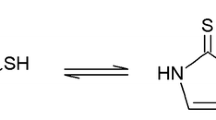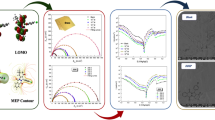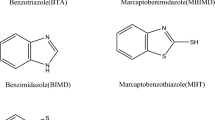Abstract
1,3,5-tri-p-tolyl-1,3,5-triazene was investigated as a corrosion inhibitor for brass in 0.5 M HCl solution using weight loss, potentiodynamic polarization, linear polarization resistance and electrochemical impedance spectroscopy. Data obtained from these methods showed average inhibition efficiency (76 %) at optimum concentration. The adsorption of the inhibitor on the brass surface follows the Frumkin adsorption isotherm.
Similar content being viewed by others
Avoid common mistakes on your manuscript.
Introduction
Brass has been widely used for shipboard condensers, power plant condensers and petrochemical heat exchangers [1]. It is particularly relevant to the Indian region where various industries extensively use brass in different media and in heat exchanger tubes; for example, in desalination, cooling water systems, and power generation. Brass materials are relatively noble and for many applications have superior physical and mechanical properties, although brass can present particular corrosion problems such as dezincification and pitting corrosion in acidic solutions leading to structural failure [2].
Acid solution is widely used in industries, with the most important areas of application being acid pickling, industrial acid cleaning, and acid descaling [3]. Brass is not completely resistant to corrosion, especially in oxygen-containing electrolytes, but substantial improvement in its passivity can be achieved using corrosion inhibitors [4].
In recent years, the applicability of N-heterocyclic compounds as corrosion inhibitors for metals in acidic media has been widely acknowledged [5, 6]. The studied inhibitor is synthesized by an ultrasonic cleaner, which accelerates the reaction rate and reduces the reaction time to 3–4 min [7]. Triazine derivatives are reported to show wide utility as pharmaceutical ingredients and agrochemicals. Most of the well-known corrosion inhibitors are heterocyclic compounds containing polar groups (N, O and S) and conjugated double bonds in their molecular structure [8–11]. Heterocyclic compounds may act as better corrosion inhibitors for brass due to the presence of polar groups and suitable conjugations in their molecular structure, by which they can be adsorbed on the metal surface and create a physical barrier between the metal and a corrosive environment [12, 13]. The chemical structure of the inhibitor is shown in Fig. 1.
Experimental
Weight loss measurement
Weight loss measurements were carried out using brass (7:3) specimens of size 5.0 cm × 2.0 cm × 0.025 cm. The solution of 0.5 M HCl was used for all studies. All concentrations of the inhibitor used for the weight loss studies were prepared in ppm range by weight. The brass specimens were abraded with fine grade emery paper (600–1,200 grades), washed with double-distilled water, and finally degreased with acetone and dried at room temperature. Following this, the metal strips were dipped in 0.5 M HCl containing different concentrations of the inhibitor at room temperature for 168 h.
Electrochemical measurements
Electrochemical impedance measurements, potentiodynamic polarization and linear polarization studies were carried out using a GAMRY PCI 4/300 electrochemical work station based on ESA 400. Gamry applications include EIS 300 (for EIS measurement) and DC 105 software for corrosion and Echem Analyst 5.50 Software for data fitting. All the electrochemical experiments were performed in a three-electrode cell with a platinum counter electrode, and a saturated calomel electrode (SCE) as the reference electrode [14]. The working electrode was a brass strip (7.5-cm-long stem) with an exposed surface of 1.0 cm2, immersed in acidic solution with and without the inhibitor. The different concentrations of inhibitor solution were prepared by dissolving the organic inhibitor compound in 5 ml of acetone and mixing it in acid solution to maintain the concentration (ppm). The working electrode of the brass strip was prepared by dipping it in different concentrations (ppm) of inhibitor solution for 24 h. EIS measurements were performed at open corrosion potentials, E corr over a frequency range of 100 kHz to 10 mHz with the AC signal amplitude perturbation of 10 mV peak to peak. Potentiodynamic polarization studies were performed with a scan rate of 1 mVs−1 in the potential range from 250 mV below the corrosion potential to 250 mV above. All potentials were recorded with respect to the SCE.
Results and discussion
Weight loss measurements
The weight loss measurements and corrosion rate of the brass specimens in 0.5 M HCl in the presence and absence of the inhibitor are shown in Table 1. The data indicate that, on increasing the inhibitor concentration, the efficiency increases and corrosion rate decreases. These changes are due to adsorption and increase in the coverage area of the inhibitor [15] on the brass surface. The inhibition efficiency (η %), surface coverage (θ) and corrosion rate (C R) were determined by using the following equations [16],
where W is weight loss, D is density, A is area, and T is the time for the specimen.
where \( C{}_{\text{R}} \) and \( {}^{\text{inh}}C{}_{\text{R}} \) were the corrosion rates in the presence and absence of the inhibitor, respectively. The variation with increasing concentration is shown in Fig. 2.
Electrochemical measurements
Potentiodynamic polarization measurements
Polarization curves of brass in acidic solution without and with the addition of different concentrations of inhibitor are shown in Table 2. The values of electrochemical measurements associated with polarization measurements, such as corrosion potentials (E corr), corrosion current densities (i corr), polarization resistance (R p), and Tafel slopes (β a , β c) are listed in Table 2. From the polarization curves obtained (Fig. 3), the corrosion current (i corr) was calculated by curve fitting using the equations:
The inhibition efficiency was evaluated from the measured i corr values using the relationship:
where, \( i_{\text{corr}}^{ 0} \) and \( i_{\text{corr}}^{\text{i}} \) are the corrosion current density in absence and presence of inhibitor, respectively.
The obtained results show that the inhibition efficiency increases (37 to 75 %) and the corrosion current density (i corr) decreases (31.00 to 7.45 μAcm−2) when the inhibitor concentration increases. This could be explained on the basis of adsorption of inhibitor on metal surface and it increases with increase in the concentration of inhibitor and further remains constant after increasing the concentration of inhibitor [17]. The data indicate that, on increasing the inhibitor concentration, the corrosion potential values E corr shift in an anodic direction (−309 to −269 mV/SCE). The maximum displacement of E corr is not more than 80 mV, indicating that it acted as a mixed type inhibitor [18].
EIS measurement
The corrosion behavior of brass in acid solution in thepresence and absence of theinhibitor was studied by EIS technique after 30 min of immersion time. The values obtained are shown in Table 3. The Nyquist plots for inhibitor concentrations are characterized by one semi-circular capacitive loop (Fig. 4). The inhibitor gets adsorbed on the electrode surface and thereby produces a barrier for the metal to diffuse out to the bulk, and this behavior increases with increasing the inhibitor concentration. With increasing inhibitor concentration, charge transfer resistance R ct increases from 853 to 3,670 Ω cm2 and C dl values decrease from 83 to 11 μfcm−2 [19].
where Y 0 is the CPE coefficient, n is the CPE exponent (phase shift), and ω is the angular frequency.
The inhibition efficiency of the inhibitor was calculated from the charge transfer resistance values using the following equation:
where \( R_{\text{ct}}^{ 0} \) and \( R_{\text{ct}}^{\text{i}} \) are the charge transfer resistance values in the absence and presence of the inhibitor, respectively.
Linear polarization measurement
The corrosion behavior was studied with polarization resistance measurements (R p) in 0.5 M HCl solution without and with different concentrations of inhibitor as shown in Table 4. The linear polarization study was carried out from a cathodic potential of −20 mV versus OCP to an anodic potential of +20 mV versus OCP at a scan rate 0.125 mV s−1 to study the polarization resistance (R p). The polarization resistance was evaluated from the slope of the curve in the vicinity of the corrosion potential. From the evaluated polarization resistance value, the inhibition efficiency was calculated using the relationship:
where \( R_{\text{p}}^{0} \) and \( R_{\text{p}}^{i} \) are the polarization resistance in the absence and presence of the inhibitor, respectively. With the increase in the concentration of the inhibitor, the Rp value increases from 13 to 47 Ω cm2, also with an increase in efficiency.
Adsorption isotherm
The interaction between the inhibitor and the metal alloy can be explained by the adsorption isotherm. The adsorption isotherm can be defined by the surface coverage (θ)and inhibitor concentration which is adsorbed on the metal surface with increasing concentration. Several adsorption isotherms were tried to fit the values including the Frumkin, Langmuir, and Temkin isotherms. Among the three adsorption isotherms, the Frumkin adsorption isotherm was found to provide the best fit. In Fig. 5a–c, the linearly fit data obtained and the value of the regression coefficient (R 2 = 0.99968) of Fig. 5a confirm this approach.
Mechanism of inhibition
Adsorption of the inhibitor arises from the donor acceptor interactions between free electron pairs of hetero-atoms and π-electrons of multiple bonds, the vacant d-orbitals of copper present in brass. In the case of adsorption of organic compounds on the metallic surface, the planarity of the molecules must also be taken into consideration [20]. The adsorption and inhibition of triazenes is due to protonation in 0.5 M acid solution as:
The protonated triazenes molecules can be adsorbed on the surface through Cl− in 0.5 M HCl. The adsorption of the inhibitor on the metal surface takes place through its active centers, unshared electron pairs of hetero-atoms and π-electrons of the inhibitor moiety. So, the mode of adsorption depends on the affinity of the metal towards the π-electron clouds of the molecule [21]. These electrons interact with the vacant d-orbital of copper present in the brass surface and adsorb strongly, thereby blocking more adsorption sites on the brass surface [22]. It has been previously reported in the literature that an inhibiting effect depends mainly on the inhibitor concentration, the molecular structure, and the size and structure of the side chain in the organic compounds [23]. The transition of the metal/solution interface from a state of active dissolution to the passive state is attributed to the adsorption of the inhibitor molecules at the metal/solution interface, forming a protective film. The rate of adsorption is usually rapid and, hence, the reactive metal surface is shielded from the aggressive environment [24]. The adsorption of organic molecules on the solid surface cannot be considered as only a purely physical or a purely chemical adsorption phenomenon. In addition to the chemical adsorption, inhibitor molecules can also be adsorbed on the metal surface via electrostatic interaction between the charged metal surface and charged inhibitor molecules.
Conclusions
-
1.
The inhibitor studied has shown average inhibition effect for the corrosion of brass in 0.5 M HCl. The high inhibition efficiencies were attributed to the adherent adsorption of the inhibitor molecules on the brass surface.
-
2.
The adsorption of these compounds on the brass surface obeyed the Frumkin adsorption isotherm.
-
3.
Potentiodynamic polarization studies revealed that the studied inhibitor is a mixed type inhibitor.
-
4.
The results demonstrate that the inhibition process was attributable to the adsorption of inhibitor molecules on the brass surface. On the other hand, values of the obtained double layer capacitance (C dl) have shown a tendency to decrease, which can result from a decrease in local dielectric constant and/or an increase in thickness of the electrical double layer.
References
M. Abdallah, A. Al- Agez, A.S. Fouda, Int. J. Electrochem. Sci. 4, 352 (2009)
X. Joseph Raj, N. Rajendran, Int. J. Electrochem. Sci. 6, 366 (2011)
H. Ashassi-Sorkhabi, D. Seifzadeh, M.G. Hosseini, Corros. Sci. 50, 3370 (2008)
F. Bentiss, M. Lebrini, M. Lagrenee, M. Traisnel, A. Elfarouk, H. Vezin, Electrochim. Acta 52, 6872 (2007)
M. Mihit, S. El Issami, M. Bouklah, L. Bazzi, B. Hammouti, E. Ait Addi, R. Salghi, S. Kertit, Appl. Surf. Sci. 252, 2395 (2006)
M. Mihit, M. Belkhaouda, L. Bazzi, L. Salghi, S. El Issami, E. Ait Addia, Portug Electrochim. Acta 25, 480 (2007)
A.K. Singh, S.K. Shukla, M.A. Quraishi, J. Mater. Environ. Sci. 4, 406 (2011)
F.H. Assaf, M. Abou-Krish, A.S. El-Shahawy, MTh Makhlouf, HalaSoudy, Int. J. Electrochem. Sci. 2, 181 (2007)
J. Aljourani, K. Raeissi, M.A. Golozar, Corros. Sci. 51, 1843 (2009)
A.K. Singh, M.A. Quraishi, Corros. Sci. 51, 2760 (2009)
S.K. Shukla, M.A. Quraishi, Corros. Sci. 51, 1011 (2009)
I. Ahmad, M.A. Quraishi, Corros. Sci. 52, 656 (2010)
A. Popova, Corrs. Sci. 49, 2158 (2007)
M.M. El-Naggar, Corros. Sci. 49, 2236 (2007)
R. Ravichandran, S. Nanjundan, N. Rajendran, J. Appl. Electrochem. 236, 250 (2004)
A.K. Singh, M.A. Quraishi, Corros. Sci. 52, 1385 (2010)
A. Singh, I. Ahamad, V.K. Singh, M.A. Quraishi, J. Solid State Electrochem. 15, 1097 (2011)
R. Ravichandran, N. Rajendran, Appl. Surf. Sci. 241, 458 (2005)
M.A. Quraishi, A. Singh, V.K. Singh, D.K. Yadav, A.K. Singh, Mater. Chem. Phys. 122, 122 (2010)
G. Guo, C.H. Liang, Electrochim. Acta 52, 4559 (2007)
I. Ahamad, S. Khan, K.R. Ansari, M.A. Quraishi, J. Chem. Pharm. Res. 3, 717 (2011)
K.F. Khaled, Appl. Surf. Sci. 252, 4128 (2006)
I. Ahamad, C. Gupta, R. Prasad, M.A. Quraishi, J. Appl. Electrochem. 40, 2183 (2010)
I. Ahamad, R. Prasad, M.A. Quraishi, Corros. Sci. 52, 1481 (2010)
Author information
Authors and Affiliations
Corresponding author
Rights and permissions
About this article
Cite this article
Singh, P., Singh, A. & Quraishi, M.A. Inhibition effect of 1,3,5-tri-p-tolyl-1,3,5-triazene on the corrosion of brass in 0.5 M HCl solution. Res Chem Intermed 40, 595–604 (2014). https://doi.org/10.1007/s11164-012-0985-z
Received:
Accepted:
Published:
Issue Date:
DOI: https://doi.org/10.1007/s11164-012-0985-z









